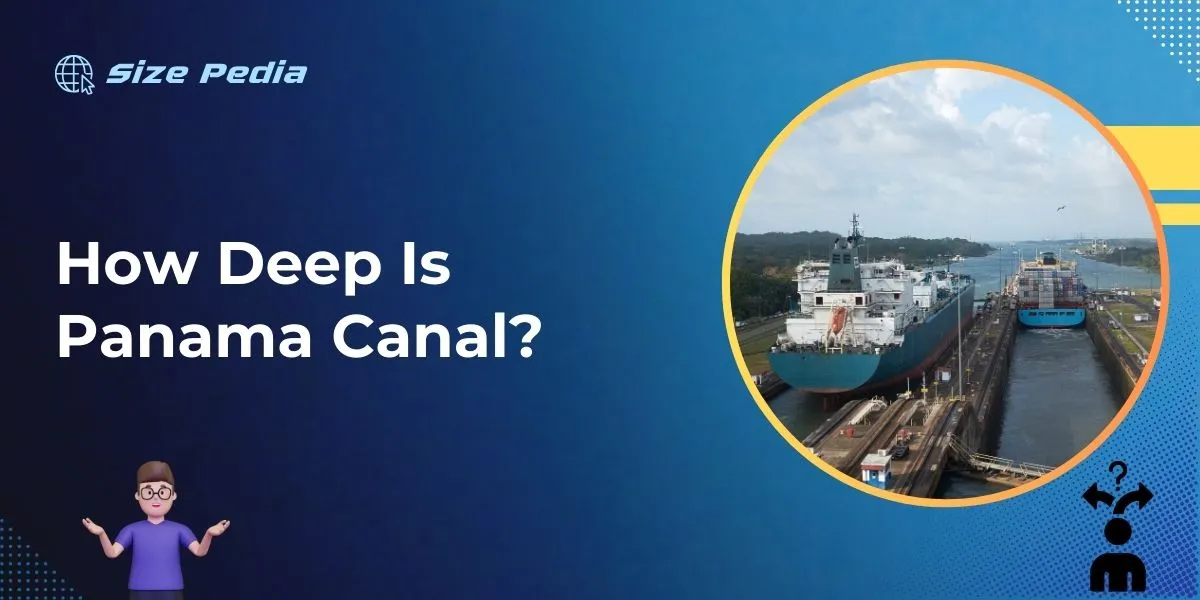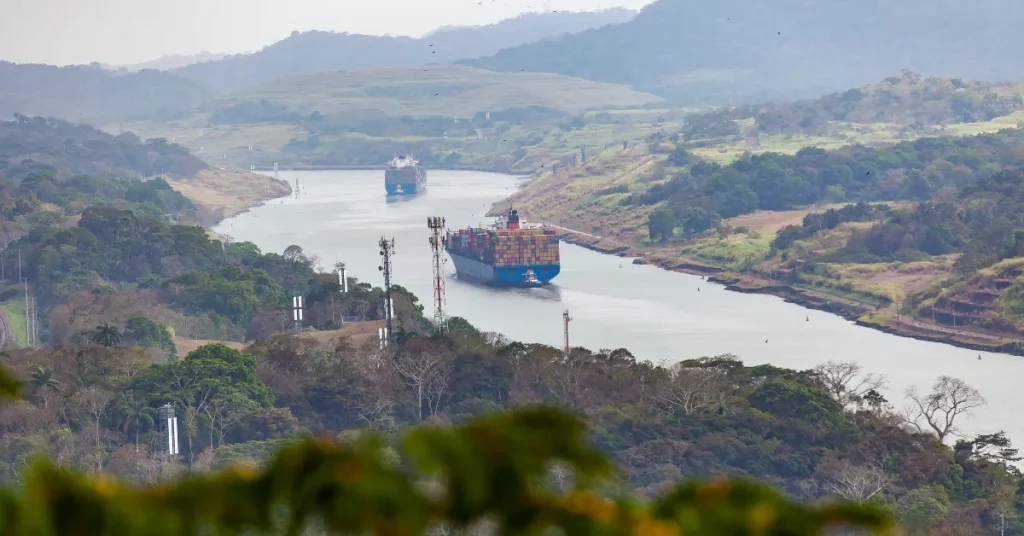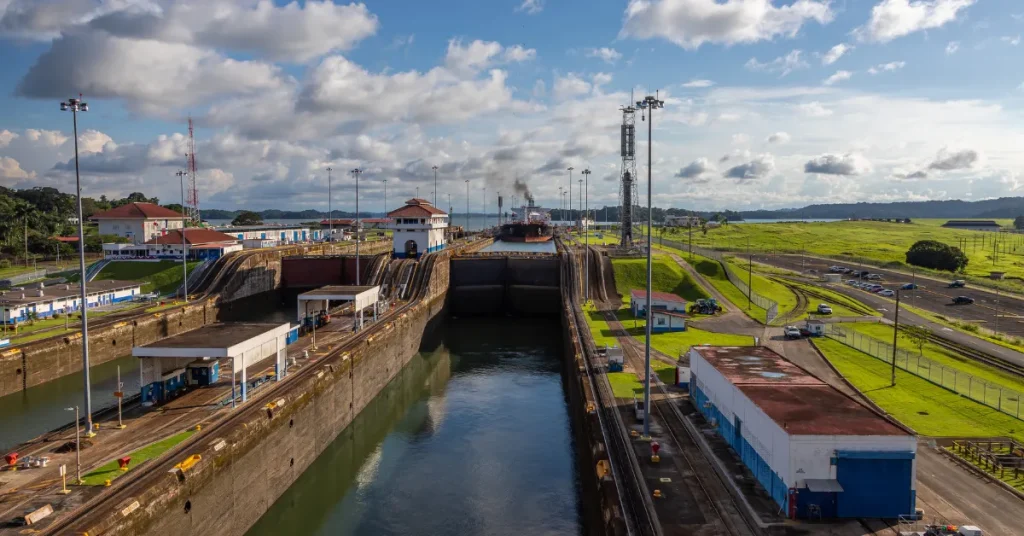The Panama Canal has a maximum depth of about 85 feet (26 meters). It averages a depth of 50 feet (15.2 meters).
The Panama Canal, an engineering marvel that connects the Pacific and Atlantic oceans, is a vital artery for international maritime trade.
Its construction spanned from 1904 to 1914, forever transforming global shipping routes. The canal cuts across the Isthmus of Panama, significantly reducing the voyage around the tip of South America.
Ships passing through this 50-mile waterway benefit from a safe and efficient corridor, thanks to the canal’s impressive lock system that lifts vessels over 85 feet above sea level.
This man-made wonder not only serves as a testament to human ingenuity but also boosts the economy by facilitating faster and more cost-effective transportation of goods worldwide.

Sailing Through History
Sailing through history, the Panama Canal stands as a testament to human ingenuity and perseverance. This engineering marvel has facilitated global trade for over a century, connecting the Atlantic and Pacific Oceans.
Its waters carry the stories of early explorers, challenging construction, and the continuous evolution mirroring the dynamic world of maritime commerce.
Beginnings Of The Panama Canal
The tale of the Panama Canal starts in the early 1500s. Spaniards first dreamt of a path that could link the oceans. Centuries later, the French commenced the colossal task, but they faced devastating failure due to disease and engineering challenges.
It was not until the United States took over in 1904 that the dream transformed into a concrete reality.
- Conceptualized: by the Spanish Crown
- Attempted: first by the French in 1881
- Completed: by the U.S. in 1914
On completion, the waterway stretched approximately 50 miles and utilized a system of locks to lift ships over the Continental Divide.
Expansion And Modernization
Recognizing the need to accommodate larger vessels, Panama launched an expansion project. In 2016, the world witnessed the unveiling of new, wider channels and locks, capable of handling modern mega-ships.
- Expansion proposed: in 2006
- Construction began: 2007
- Inauguration of new locks: 2016
This modernization illustrates Panama’s commitment to staying at the forefront of maritime logistics. The canal not only deepened in physical depth but also in its significance to global trade networks.
The Canal’s Design
The Panama Canal stands as a marvel of modern engineering. Its design reflects a blend of function and innovation.
This intricate waterway allows ships to journey between the Atlantic and Pacific Oceans. It does so by navigating a system of locks, lakes, and man-made channels.
Locks And Lakes
The Panama Canal’s depth varies in different segments. In the lock areas, chambers lift and lower ships. These chambers have a minimum depth of 41.2 feet or about 12.5 meters. This depth is crucial for the safe passage of large vessels.
Significant lakes also contribute to the canal’s path. Lake Gatun, an artificial lake, forms a key segment. It elevates ships to 85 feet above sea level. The lake’s depth reaches up to 85 feet allowing safe navigation for ships.
Engineering Achievements
The construction of the Panama Canal was a groundbreaking achievement. Engineers had to design a system that could handle extreme variations in sea level. They also had to consider the volume and size of ocean-going vessels.
- Lock chambers, created to raise and lower ships, extend 1,000 feet in length and 110 feet wide.
- The canal employs a dual-lane system, allowing ships to pass in both directions simultaneously.
- More than 5 million cubic yards of concrete were used in the original construction of the locks.
Panama Canal Depths

The Panama Canal is a marvel of engineering, connecting the Atlantic and Pacific Oceans. Its depths play a crucial role in safe passage for ships. Understanding these depths is key to the operations and management of the Canal.
Minimum And Maximum Depths
The Panama Canal has varying depths. The shallowest points, or minimum depths, are 41 feet deep. This ensures even large vessels can navigate safely.
At its deepest, the Canal spans up to 85 feet. These measurements ensure the transit of a broad range of ships.
Impact Of Tides And Rainfall
Tides and rainfall significantly alter Canal depths. The Pacific end experiences strong tidal swings. This affects the operational water levels.
Rainfall increases water levels in the Canal’s lakes. It helps maintain adequate depth for ship transit.
- High Tide: Can cause a rise in water levels.
- Low Tide: Leads to a decrease in water levels.
Navigational Challenges
The Panama Canal is a marvel of engineering, but navigating it is not without its challenges.
Ships must be precise when traversing this narrow man-made channel. Knowing the intricacies of the canal’s depth and width is vital for safe passage.
The harmonious coordination between vessel captains and canal pilots underscores the complexity of these navigational challenges.
Size Restrictions For Vessels
The Panama Canal imposes specific limitations on the dimensions of ships that can pass through.
These limits are known collectively as the Panamax criteria. The canal’s dimensions set a maximum length of 294.13 meters (965 ft), a width of 32.3 meters (106 ft), and a depth of 12.55 meters (41 ft) for vessels.
This establishes a clear boundary for the types of ships that can use the Canal effectively and safely.
| Dimension | Maximum |
| Length | 294.13 meters (965 ft) |
| Width | 32.3 meters (106 ft) |
| Depth | 12.55 meters (41 ft) |
The Role Of Canal Pilots
A successful transit through the Panama Canal largely depends on the expertise of highly trained canal pilots.
These individuals take control of the navigating vessel, using their deep knowledge of the canal’s characteristics and weather patterns.
The pilots communicate closely with the ship’s captain, ensuring the vessel adheres to the canal’s regulations. This collaboration between ship captains and pilots is essential to prevent accidents and maintain a steady flow of maritime traffic.
- Understand the Canal: Pilots are experts in the canal’s unique features.
- Safety First: They prioritize safety, guiding the ship through the waterway.
- Manage Traffic: Pilots maintain the flow, preventing congestion and delays.
Economic Impact And Importance
The Panama Canal is a cornerstone of modern global trade. This man-made marvel revolutionized marine traffic and continues to play a key role in world economics. Its impact stretches far beyond its immediate vicinity.
Global Trade And The Canal
As a vital shortcut, the Panama Canal facilitates the movement of goods worldwide. Let’s explore its unparalleled significance to global commerce:
- Reduces shipping times and distances between the Atlantic and Pacific.
- Connects over 140 sea routes and 170 countries.
- Serves as a critical conduit for international trade operations.
| Sector | Impact |
| Agriculture | Fast delivery of perishable goods |
| Manufacturing | Efficient supply chain management |
| Energy | Quick transfer of oil and gas |
Revenue From Passage Fees
The economic importance of the Panama Canal is partly measured by its revenue generation capabilities.
- Transit fees based on vessel size and cargo volume bolster the Panamanian economy.
- Sustainable toll pricing ensures consistent maritime passage demand.
- Profitable operations support canal enhancements and local economic development.
In 2020, the canal generated over $2.4 billion in tolls, showcasing its role as an economic powerhouse.
Future Prospects of Panama Canal

The Panama Canal stands as a testament to human ingenuity, a true marvel of engineering. Its depth and intricate lock systems have serviced ships for over a century.
Yet, as the world and its maritime demands evolve, so too must the canal. The future prospects of this crucial waterway hinge on expansion plans and sustainability efforts designed to meet the challenges of the coming decades.
Expansion Plans
The Panama Canal Authority recognizes the need to stay ahead. Significant expansion plans are in motion. These focus on accommodating larger vessels.
The canal’s ability to handle New Panamax ships is just the beginning. Plans for even larger locks and channels are now under review. This will ensure the canal remains a key global shipping route.
The prospects include:
- Widening existing channels to minimize congestion
- Deepening the canal to accommodate heavier ships
- Building new locks for larger vessels
- Improving logistics services around the canal zone
Sustainability And Conservation Efforts
Sustainability stands as a core pillar for the canal’s future. The waterway’s administrators focus on conservation and efficiency. Fresh water management is a current priority. It ensures the canal can continue its operations without environmental compromise.
| Conservation Element | Strategy |
| Water Usage | Optimized by Water-Saving Basins |
| Carbon Footprint | Reduced through Green Initiatives |
| Ecological Impact | Monitored to Protect Biodiversity |
These sustainability ambitions go hand in hand with educational outreach. They empower local communities. This ensures the canal’s prosperity aligns with the well-being of the surrounding ecosystem and its inhabitants.
FAQs About How Deep Is Panama Canal
What Is The Depth Of The Panama Canal?
The Panama Canal has a minimum depth of approximately 12. 5 meters (41 feet). This depth is maintained to ensure safe passage for ships.
How Was The Panama Canal’s Depth Determined?
The depth of the Panama Canal was determined by the size of ships it was designed to accommodate. It had to be deep enough for the naval and commercial vessels of the early 20th century.
Can Large Ships Navigate The Panama Canal Today?
Yes, large ships can navigate the Panama Canal. The expansion completed in 2016 allows New Panamax vessels with a draft up to 50 feet to pass.
What Factors Affect The Panama Canal’s Water Depth?
Seasonal rainfall and water usage affect the Panama Canal’s depth. The canal operates a lock system requiring water to raise and lower ships, which uses reservoir water.
Conclusion
Exploring the depths of the Panama Canal uncovers a marvel of engineering. This waterway boasts a maximum depth of approximately 85 feet. It serves as a vital conduit for global maritime trade. Sailing across this iconic channel, vessels rely on its carefully maintained depths.
From massive container ships to leisure craft, the Panama Canal’s dimensions facilitate a seamless passage between oceans, making it a cornerstone of international shipping routes.
Resources:
1. https://history.state.gov/milestones/1899-1913/panama-canal
